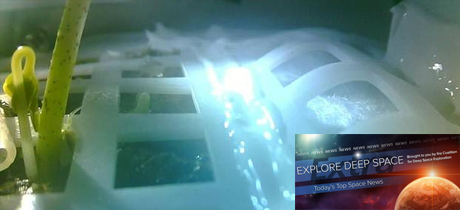In Today’s Deep Space Extra… Partial U.S. government shutdown threatens to slow NASA Space Launch System (SLS) development. NASA’s Jim Bridenstine and Russia’s Dmitry Rogozin speak by phone after an invitation for the Russian space agency head is rescinded. China says cotton seed has sprouted on the Moon’s far side.
Human Space Exploration
Shutdown puts crimp in Space Launch System (SLS) testing
Coalition Member in the News – Boeing
Politico (1/14): The partial U.S. government shutdown, which began December 22 forcing some workers to be furloughed and others to continue working without pay, is beginning to have an impact on efforts to develop the Space Launch System (SLS), the large rocket that is to start a new generation of human explorers on missions of deep space exploration. “If we got into a big delay due to the furlough, it could really delay the American return to the Moon,” according to Boeing’s John Shannon, who oversees the effort. NASA has set a goal of reaching the Moon’s surface with astronauts by 2028.
Bridenstine and Rogozin speak by phone after cancelled visit
SpaceNews.com (1/15): NASA Administrator Jim Bridenstine and Dmitry Rogozin, the head of Russia’s space agency, spoke by phone on Monday. The phone chat followed Bridenstine’s recent cancellation of an invitation extended by him to Rogozin to travel to the U.S. in February for a face to face talk on space cooperation. The invitation was rescinded at the urging of some members of Congress. Rogozin, then Russia’s deputy prime minister, was sanctioned several years ago because of his role in the Russian annexation of Crimea. Though confirming the call, a NASA spokesperson would not discuss the topics the two leaders discussed because of the ongoing U.S. government shutdown that includes NASA’s civil service workforce.
Space Science
China says it exchanged data with NASA on far side landing
Associated Press via Washington Post (1/14): NASA and China’s space agency exchanged information on the January 3 landing of the Chang’e 4 lander rover, the first spacecraft to touchdown on the Moon’s far side. In 2011, U.S. Congressional appropriators banned bilateral cooperation. However, China shared landing coordinates so NASA could obtain photos of the landing site.
China focus: Moon sees first cotton-seed sprout
Xinhuanet of China (1/15): China’s Chang’e 4 far side Moon lander mission has succeeded in growing cotton from seeds contained in a small experimental biosphere aboard the spacecraft. Other plants and the eggs of fruit flies were included in the experiment, which is intended to investigate how the living organisms might contribute to future human lunar life support systems. Potato seeds are aboard as well.
Repairing, and building, future space telescopes
The Space Review (1/14): Recent difficulties with science instrumentation and guidance devices on the aging Hubble space telescope are placing a spotlight on the significance of being able to service space based observatories. Hubble was launched in 1990 and underwent the last of five NASA shuttle astronaut servicing missions in 2009, two years before the shuttle fleet was retired. Hubble’s successor, the James Webb Space Telescope (JWST), is to reside well beyond the Earth orbiting HST, too far with current technologies to be serviced by astronauts. Despite the added costs, it may make sense to develop future space observatories with a servicing capability in order to justify the overall expense and science objectives, writes TSR editor Jeff Foust.
Hubble space telescope will last through the mid-2020s, report says
Space.com (1/14): Though experiencing recent problems with its Advanced Camera for Surveys, the Hubble space telescope should continue to function into the mid-2020s, according to an assessment presented before the American Astronomical Society (AAS) in Seattle, Washington last week. Launched in April 1990, Hubble is to be succeeded by the James Webb Space Telescope (JWST). The agency is confident it will soon restore with Advanced Camera for Surveys.
Other News
Why the Chang’e-4 Moon landing is unique
The Space Review (1/14): China’s first ever successful landing of a lander/rover on the Moon’s far side earlier this month could have long term benefits for Beijing’s plans to establish a human lunar research base, one intended to take advantages of lunar resources, such as water ice. With success, the strategy could bring down the cost of interplanetary travel.
Op-Ed | In 2019 let’s address the ‘real problems’ in national security space
SpaceNews.com (1/13): In an op-ed, Mike Rogers, a former Michigan congressman, urges more definition of national security issues before lawmakers proceed with an initiative to establish a sixth branch of the U.S. military, the Space Force. “The rush to a military space service will be distracting to other urgent changes we must make in the way America defends herself in space,” he writes.
Tethers Unlimited space venture lays off 20 percent of staff due to NASA shutdown
GeekWire.com (1/13): The partial U.S. government shutdown has confronted Tethers Unlimited, Inc., of Bothell, Washington, with a cash crunch that forced the company to lay off a dozen engineers, or 20 percent of the 25-year-old company’s workforce. Tethers Unlimited is involved in the development of new spacecraft thruster systems and space based fabrication systems.
Iran launches satellite despite Pompeo’s warning, but it fails to reach orbit
Sputnik International, of Russia (1/15): Iran proceeded with the launch of a domestic rocket over the objections of U.S. Secretary of State Mike Pompeo and others, who cited a U.N. Security Council resolution and Iran’s efforts to establish a nuclear program. Though Iran proceeded, the rocket failed to reach orbit.

